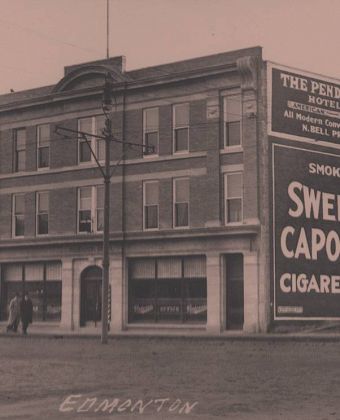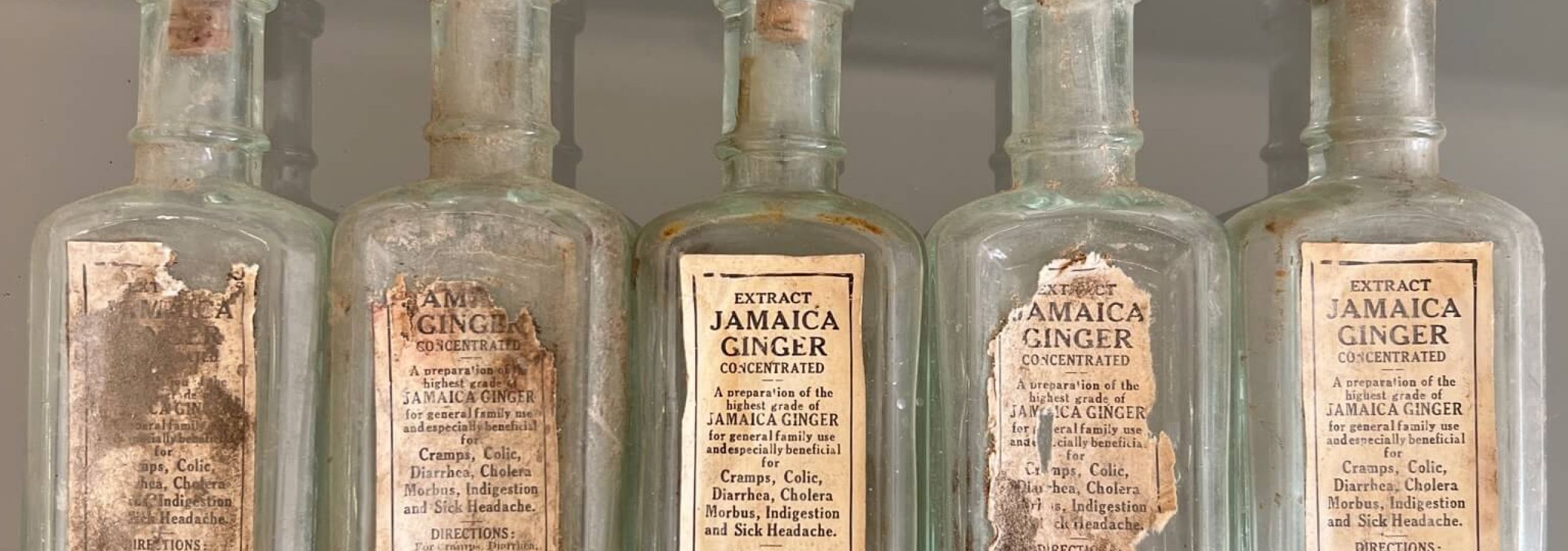
Discovery of Historical Artifacts Unearthed Inside the Pendennis Building
The Hidden Gems found in the Pendennis Building
Before the Pendennis became the beautifully restored building that perfectly meshes history with modern design, it was a turn-of-the-century hotel with an eclectic past.
A key meeting place of Edmonton’s society; it hosted an interesting mix of different people and cultures whose lives intersected at the vibrant spot on Jasper Avenue. This continued on as the hotel changed ownership and became apartments and a boarding lodge over the decades.
While we may never know the identities of everyone who stepped foot in the building, some left behind interesting traces of their existence and ways of life. Over 100 artifacts were recovered in the 2007 interior demolition of the wooden, weathered and worn structure. They ignite the curiosity of who these hotel guests and tenants really were and what brought them to the historic Pendennis over the years.
“I think the stories are fascinating,” explains Edmonton Architect David Murray, who has been involved in cataloging many of the Pendennis recovered items. “And the building is just a repository for a lot of them. With a hotel, you have more stories than you might normally have, just because so many people came through a hotel. And they left things behind. And they’re so different as well, which reflects on how diverse our city actually was.”
Stuffed into the old attic, walls and closets were a variety of everyday things like hats, clothing, cosmetics, pharmaceuticals, tobacco pouches, receipts, letters, lottery tickets, and multi-language books. Interesting items such as snake-oil drugs, a pamphlet on Hypnotism, a box of ammunition from London, new settler information, immigration papers, and extensive medical records were also left behind.
Collectively, they capture a unique snapshot of Edmonton’s historic past.
A few preserved Pendennis artifacts include:
- A detailed 1909 school speller: Not for a student child, but likely from an immigrant trying to learn English. David noted it belonged to a man named Sam Malofie born in 1878. He traced him through the city’s historical business Henderson’s Directory as the owner of the High Class Second-Hand Clothing Store on Jasper Ave. He found additional account ledgers and letters written by Sam to associates in broken English.
- An application for Edmonton’s first match making company: Bachelors looking for love – or more likely marriage – through the 1917, “Dan Cupid & Little Arrows”, dating service. For a $5 annual membership fee, men could join (women were free). There were questions about the bachelor’s wealth, their current state of health, and whether they are known in the community to be of “good moral character.” The company tag line was, “Get Married, be Happy.”
- A colourful collection of liquor and glass bottles including Jamaica ginger bottles: At the turn of the century, Jamaica ginger was widely used as a remedy for a number of ailments including headaches, respiratory infections, and intestinal gas.
- Kewpie Doll: A popular pop culture figurine based off a 1909 comic strip. Early versions were made out of ceramic bisque and then plastic and rubber by the 1940’s
- 1937 Playbill from the Capitol Theatre on Jasper Avenue: Where locals met up and were entertained with the first talking pictures in Edmonton.
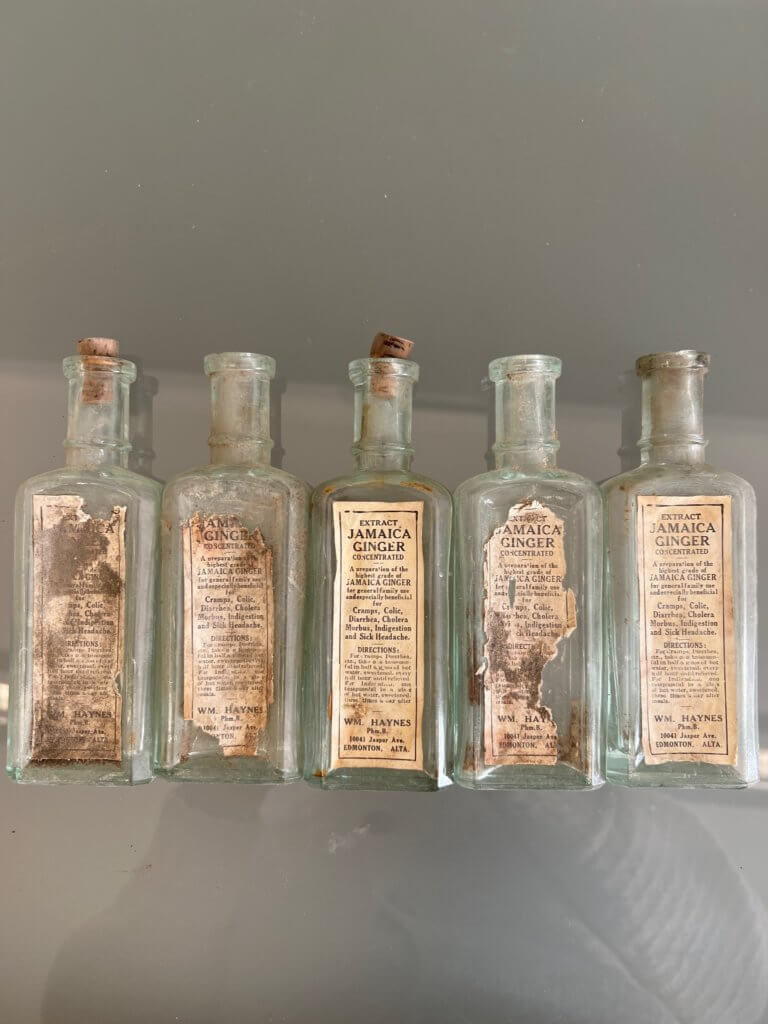
Collection of glass jars 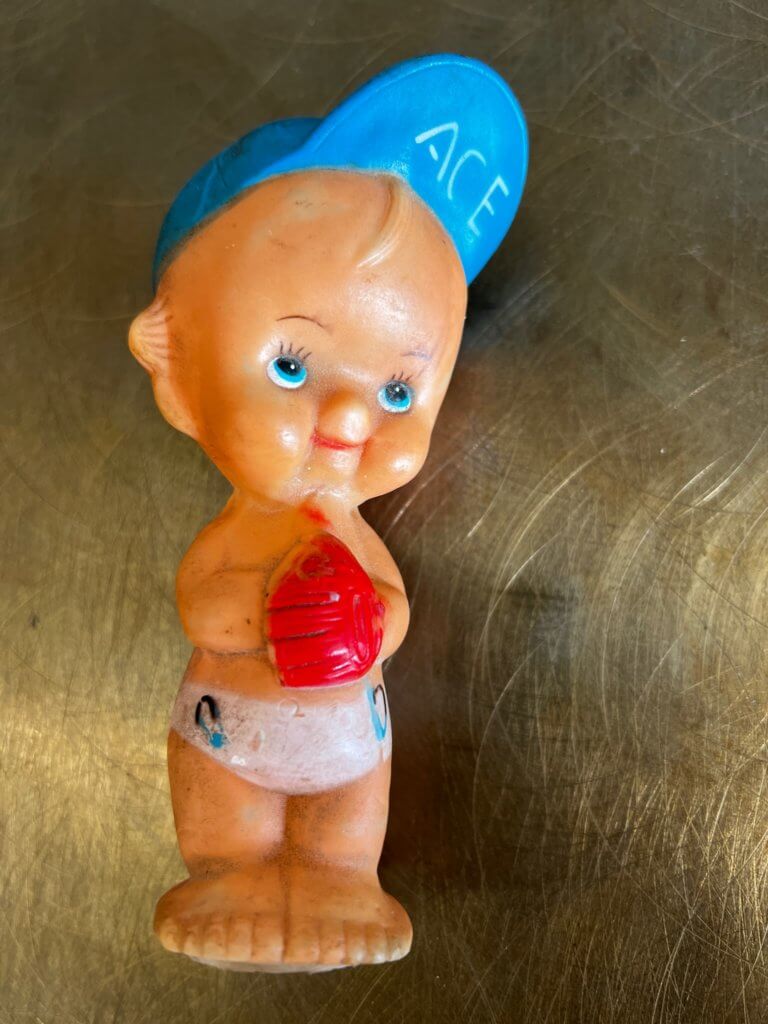
- Kewpie Doll
found in the Pendennis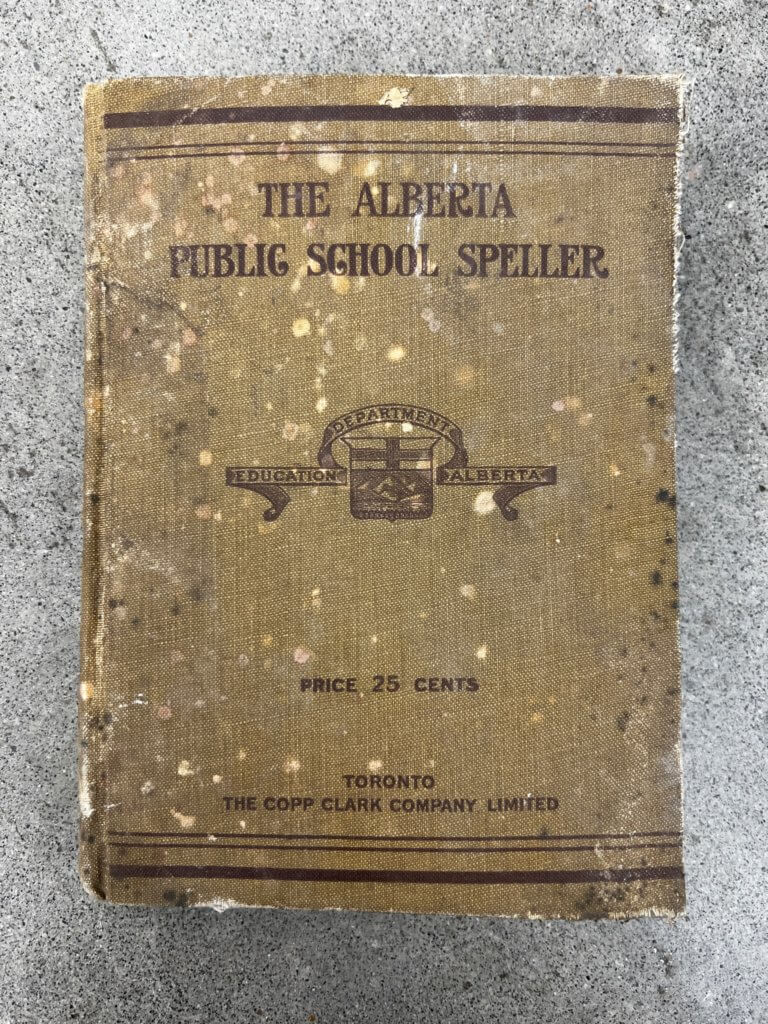
- A detailed 1909 school speller
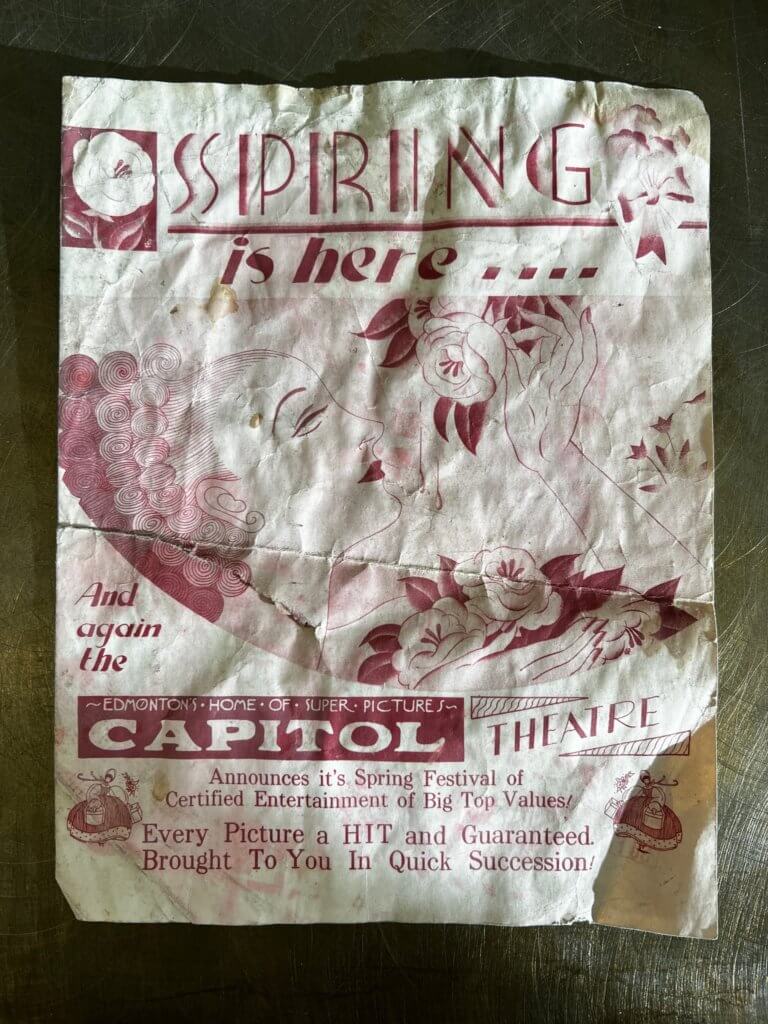
Poster for a Festival at Capital Theatre
Hidden treasures like these were unexpected. “A lot of it is relatively ordinary. But it was life at the time, and you just don’t typically have exposure to all that at once” says David. “When Delnor Construction started the interior demolition fifteen years ago, we didn’t even know how old the building was because we hadn’t done that research,” he adds. “And then the construction workers started collecting things and bringing them to us. We began to realize the history of the building and that these items were pretty significant.”
David was brought on board originally for parts of the restoration and redevelopment of the Pendennis in the early 2000’s. Although his work was complete in a few years and the extensive project continued on with Next Architecture, he felt a strong connection to the historical finds discovered in the demo. The items actually belonged to Ukrainian Canadian Archives and Museum of Alberta who at the time owned the building. When they changed ownership of the structure, the collection had become shelved. Last winter he learned the items were on the verge of being given away, so he drove out to the St. Albert warehouse where they were being stored and rescued the lot.
David spent the course of the year cleaning, organizing and cataloguing objects and created 122 working files he stored in his office. In essence he became an expert “Pendennis detective,” and spent countless hours digging up as much research on the items that he could find.
Connectection to California
The architect is particularly intrigued by the many American artifacts left behind in the Pendennis.
“The connection with California is very interesting,” he says. Adventurous fortune seekers from the United States likely made their way up to Edmonton as a stopover to the Yukon during the Klondike Gold Rush. In fact, the original Pendennis building is traced back to an 1898 simple wooden structure on the sparsely populated Jasper Avenue that was first known as the “California Rooming House.”
One of David’s favourite finds is from the western State. It’s a worn but intact Liberty Dairy (Established 1869) business card owned by William G. Loewe, Proprietor. The business card came with an account book with entries from 1902. The dairy farm was located outside of San Francisco, but when David checked the 1899 San Francisco directory, he found they had an office located at the corner of Russia Avenue and Vienna in the California city. He wonders what brought Loewe to Edmonton, if he was here for business or adventure, and what stories he would have to tell about his trip across the country.
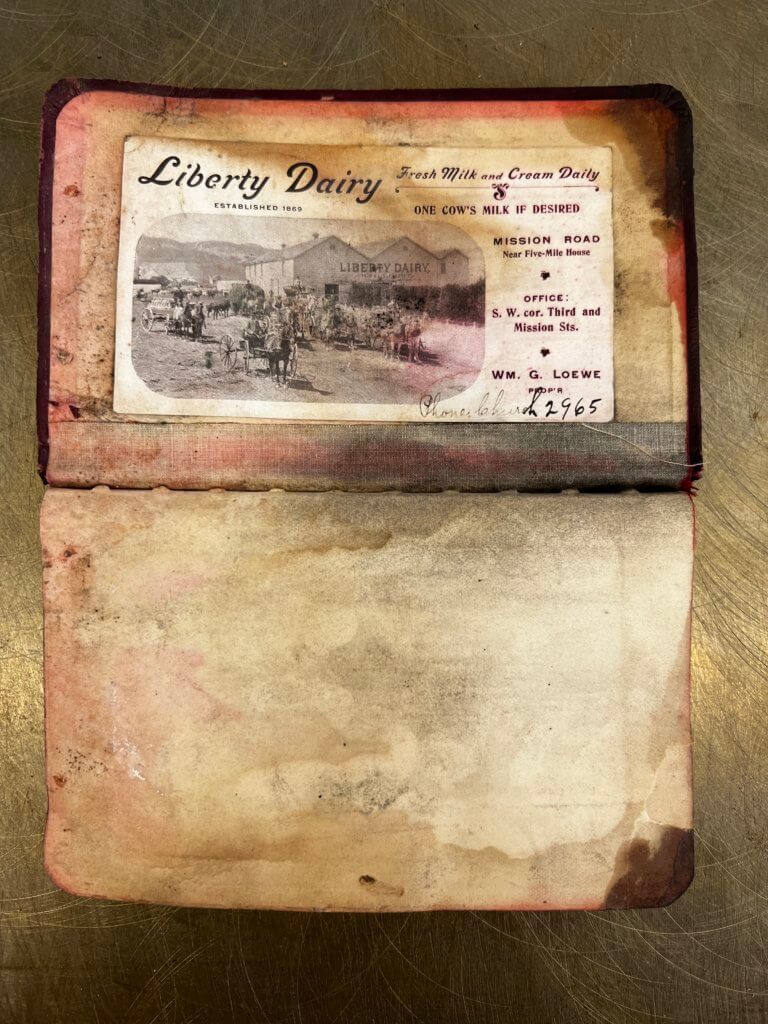
Meal tickets and a business card to the Ellis Bakery & Restaurant in San Francisco from the early 1900’s were also found in the ruins. In addition, there were early maps of California, maps of western Canada and the Alberta peace country; with the old trail systems, major rivers and the Athabasca River included on the prints.
A 1903 Union Pacific train schedule leads David to say, “I see a connection that someone had taken the Union Pacific to get up here from San Francisco. Most likely the Union Pacific would have made its way to San Francisco, and then up to Chicago. From there they would have taken a train to Winnipeg, and then the CPR train to Calgary and Edmonton.” There’s more evidence of rail travel with “Frisco Lines” playing cards that must have been from a train, and which he concludes “eventually ended up in a hotel closet.”
One of the oldest dated items found at the Pendennis is an account book from 1889 – 1895. It likely belonged to an American because there is an entry on May 30th noted as “Decoration Day.” This was a national U.S. holiday where mourners honored the Civil War dead by decorating their graves with flowers.
Tools of the past
Another item that caught David’s eye is a highly unusual sharp, technical tool he discovered to be a double cherry pitter. The late 1880’s American contraption was built and manufactured by the Goodell Company of Antrim, New Hampshire, and found its way to the hotel. Fresh BC cherries could have been delivered by the CPR rail from the Okanagan to Edmonton, pitted at the Pendennis with the modern device, and served in delicious entrees at its top-rated restaurant. (Find out more about the Pendennis cherry pitter in David’s industry article “Lost Devices” https://issuu.com/onsitereview/docs/onsite39tools)
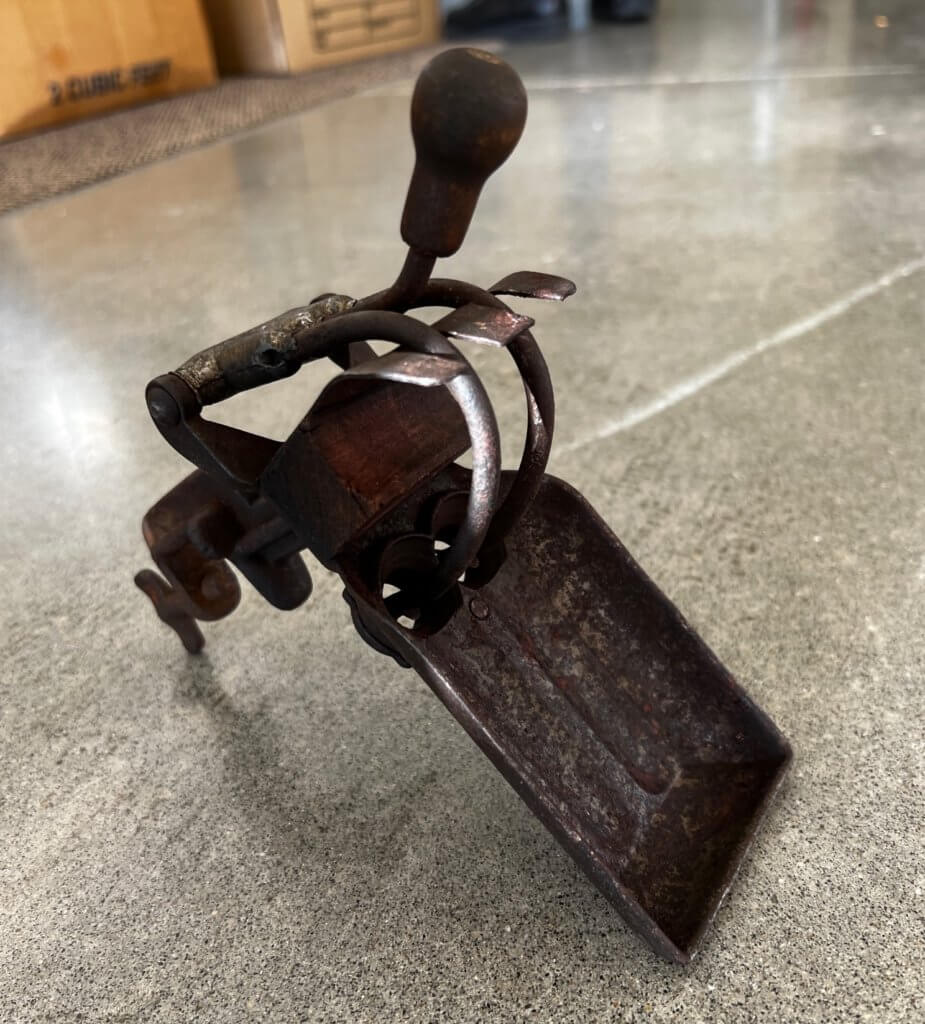
In addition to the architect’s rescued boxes of artifacts, the nearby St. Albert museum has another 50 Pendennis items they displayed in a previous Klondike exhibit.
David, who is also a member of the Edmonton Historical Board, would love to see an eventual permanent home for all the objects. “I don’t feel any particular ownership for them, but I think they are going to be very important to the City of Edmonton. So they have to be saved, they have to be conserved somehow; we have to know what they are, as they are a part of who we are. There’s a lot of research that can be conducted to understand the building’s recovered items better and find all the stories that are associated with them. “
He adds, “Then they’re here for people in the future. And actually, these Pendennis artifacts will become more interesting and relevant as time goes on as well. Because the further back you go back in time, the rarer it is to find evidence of that time, so it is essential to learn about, share and preserve these items today.”
As the Pendennis is poised to become the centre of new exciting stories in the redesigned modern workspace, we are thrilled to celebrate its past and valuable contribution shaping Edmonton’s cultural identity and downtown core. You can see more Pendennis historical artifacts photos at:
